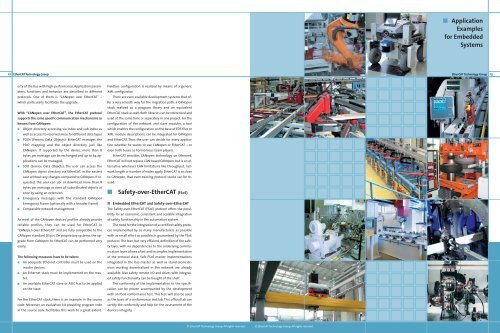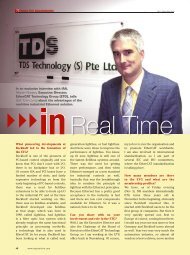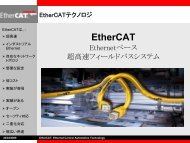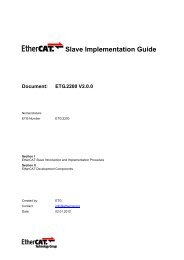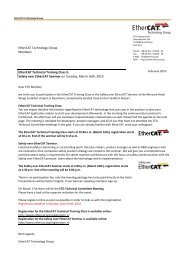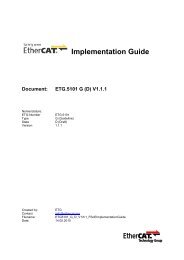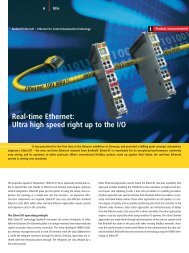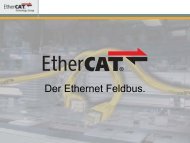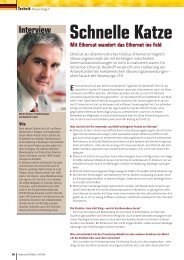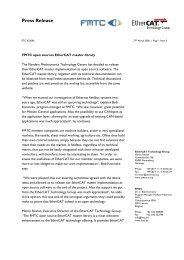EtherCAT for Embedded Systems
EtherCAT for Embedded Systems
EtherCAT for Embedded Systems
Create successful ePaper yourself
Turn your PDF publications into a flip-book with our unique Google optimized e-Paper software.
12 <strong>EtherCAT</strong> Technology Group<br />
■ Distributed clocks<br />
Accurate synchronization is particularly important in cases<br />
where spatially distributed processes require simultaneous<br />
actions. This may be the case, <strong>for</strong> example, in applications<br />
where several servo axes carry out coordinated movements<br />
simultaneously.<br />
The most powerful approach <strong>for</strong> synchronization is the<br />
accurate alignment of distributed clocks, as described <strong>for</strong><br />
example in the IEEE 1588 standard [6]. In contrast to fully<br />
synchronous communication, where synchronization quality<br />
suffers immediately in the event of a communication<br />
fault, distributed aligned clocks have a high degree of tolerance<br />
versus possible fault-related delays within the communication<br />
system.<br />
With <strong>EtherCAT</strong>, the synchronization of the devices is<br />
fully based on a pure hardware machine. Since the communication<br />
utilizes a logical (and thanks to full-duplex Fast<br />
Ethernet also physical) ring structure, a timestamp can be<br />
sampled within each device <strong>for</strong> the incoming and the returning<br />
frame. With these timestamps the master can determine<br />
the propagation delay offset to the individual<br />
slave clocks simply and accurately (see Fig. 7). The distributed<br />
clocks are adjusted based on this value, which means<br />
that a very precise network-wide time base with a jitter of<br />
significantly less then 1 microsecond is available (see<br />
Fig. 6). External synchronization, e.g. across the plant, is<br />
then based on IEEE 1588. However, high-resolution distributed<br />
clocks are not only used <strong>for</strong> synchronization, but can<br />
■ Figure 6: Synchronicity and Simultaneousness: Scope view of two distributed<br />
devices with 300 nodes and 120m of cable between them<br />
also provide accurate in<strong>for</strong>mation about the local timing<br />
of the data acquisition. For example, motion controllers<br />
typically calculate velocities from sequentially measured<br />
positions. Particularly with very short sampling times, even<br />
a small temporal jitter in the position measurement leads<br />
to large step changes in the computed velocity.With Ether-<br />
CAT, timestamp data types are introduced as a logical extension.<br />
The high resolution system time is linked to the<br />
measured value, which is made possible by the large bandwidth<br />
offered by Ethernet. The accuracy of a velocity calculation<br />
then no longer depends on the jitter of the communication<br />
system. It is orders of magnitude better than that<br />
of measuring techniques based on jitter-free communication.<br />
■ Per<strong>for</strong>mance<br />
<strong>EtherCAT</strong> reaches new dimensions in network per<strong>for</strong>mance.<br />
Thanks to hardware integration in the slave and direct<br />
memory access to the network controller in the master,<br />
the complete protocol processing takes place within<br />
hardware and is thus fully independent of the run-time of<br />
protocol stacks, CPU per<strong>for</strong>mance or software implementation.<br />
The update time <strong>for</strong> 1,000 I/Os is only 30 μs – including<br />
I/O cycle time (see Table 1). Up to 1486 bytes of<br />
process data can be exchanged with a single Ethernet<br />
frame – this is equivalent to almost 12,000 digital inputs<br />
and outputs. The transfer of this data quantity only takes<br />
150 μs. The communication with 100 servo axes is also ex-<br />
■ Figure 7: Setting the indivual clocks of each device to the network-wide time base.<br />
M<br />
Δt<br />
s<br />
s s s s s<br />
s<br />
© <strong>EtherCAT</strong> Technology Group. All rights reserved.<br />
■ Table 1: <strong>EtherCAT</strong> Per<strong>for</strong>mance Overview<br />
© <strong>EtherCAT</strong> Technology Group. All rights reserved.<br />
tremely fast: every 100 μs, all axes are provided with command<br />
values and control data and report their actual position<br />
and status. The distributed clock technique enables<br />
the axes to be synchronized with a deviation of significantly<br />
less than 1 microsecond. And even at this pace, there<br />
is more than sufficient bandwidth <strong>for</strong> asynchronous communications<br />
such as TCP/IP, parameter download or diagnostic<br />
data upload.<br />
The extremely high per<strong>for</strong>mance of the <strong>EtherCAT</strong> technology<br />
enables control concepts that could not be realized<br />
with classic fieldbus systems. With <strong>EtherCAT</strong>, a communication<br />
technology is available that matches the superior<br />
computing capacity of modern Industrial PCs. The bus system<br />
is no longer the bottleneck of the control concept. Distributed<br />
I/Os are recorded faster than is possible with most<br />
local I/O interfaces. The <strong>EtherCAT</strong> technology principle is<br />
scalable and not bound to the baud rate of 100 Mbaud –<br />
extension to Gbit Ethernet is possible.<br />
■ Diagnosis<br />
Experience with fieldbus systems shows that availability<br />
and commissioning times crucially depend on the diagnostic<br />
capability. Only faults that are detected quickly and<br />
accurately and located unambiguously can be rectified<br />
quickly. There<strong>for</strong>e, special attention was paid to exemplary<br />
diagnostic features during the development of <strong>EtherCAT</strong>.<br />
During commissioning, the actual configuration of the<br />
nodes (e.g. drives or I/O terminals) should be checked <strong>for</strong><br />
Process Data Update Time<br />
256 distributed digital I/O 11 μs = 0,01 ms<br />
1000 distributed digital I/O 30 μs<br />
200 analog I/O (16 bit) 50μs ↔ 20 kHz<br />
100 Servo Axis, with 8 Bytes<br />
input and output data each<br />
100 μs<br />
1 Fieldbus Master-Gateway<br />
(1486 Bytes Input and<br />
1486 Bytes Output Data)<br />
150 μs<br />
■ Figure 8: Low cost cable redundancy with standard slaves<br />
<strong>EtherCAT</strong> Technology Group<br />
consistency with the specified configuration. The topology<br />
should also match the configuration. Due to the built-in<br />
topology recognition down to the individual terminals,<br />
this verification can not only take place during system<br />
start-up, automatic reading in of the network is also possible<br />
(configuration up-load).<br />
Bit faults during the transfer are reliably detected<br />
through evaluation of the CRC checksum: The 32 bit CRC<br />
polynomial has a minimum hamming distance of 4. Apart<br />
from broken wire detection and localization, the protocol,<br />
physical layer and topology of the <strong>EtherCAT</strong> system enable<br />
individual quality monitoring of each individual transmission<br />
segment. The automatic evaluation of the associated<br />
error counters enables precise localization of critical network<br />
sections. Gradual or changing sources of error such as<br />
EMI influences, defective connectors or cable damage are<br />
detected and located, even if they do not yet overstrain the<br />
self healing capacity of the network.<br />
■ High availability<br />
Increasing demands in terms of system availability are<br />
catered <strong>for</strong> with optional cable redundancy that enables<br />
devices to be exchanged without having to shut down the<br />
network. Adding redundancy is very inexpensive: the only<br />
additional hardware is another standard Ethernet port (no<br />
special card or interface) in the master device and the single<br />
cable that turns the line topology into the ring (see<br />
Fig. 8). Switchover in case of device or cable failure only<br />
13


